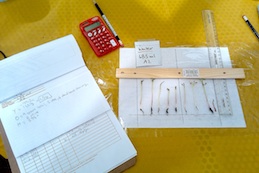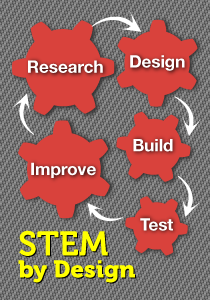How to Plan STEM Curriculum
A MiddleWeb Blog
Good news arrived via email this morning! Change the Equation has determined that the EYE Middle Grades Modules I wrote about in last week’s post meet the high standards for inclusion in their STEMworks Database. I decided to check out the Change the Equation website and look at the principles they use for including resources in their database. These principles, I figure, would be handy for teachers who want to work on STEM lessons.
Why would teachers want to write STEM lessons anyway? Why not leave this to the folks outside the classroom? If you’re a teacher, you already know the answer to that question. Teachers are the people closest to the learners. No one knows the students better, and no one knows better what works in real classrooms.
The most workable, insightful and effective lessons I taught in middle grades science were lessons I got from my teacher colleagues. I scavenged lessons from teachers in my school and district, and I eagerly shared lessons with teachers at state and national science conventions, such as the National Science Teachers Assocation.
Teachers can be a continuous resource for one another. When we grow our skills, document our successful lesson plans, and share the knowledge we accrue, we leave a lasting heritage. Even more important: we ensure that everything we know and have done during our careers lives on — it doesn’t retire with us when leave the classroom and tuck our boxes of “stuff” away in storage.
10 Principles for Developing STEM Lessons
 So, having gotten that off my chest (smile), back to the Overarching Principles established by the Change the Equation organization. With apologies to the CTEq folks who developed these great design principles, I’m liberally paraphrasing — and I’m posing some of them as questions. I think this can be a useful starting point for teachers in building effective STEM lessons.
So, having gotten that off my chest (smile), back to the Overarching Principles established by the Change the Equation organization. With apologies to the CTEq folks who developed these great design principles, I’m liberally paraphrasing — and I’m posing some of them as questions. I think this can be a useful starting point for teachers in building effective STEM lessons.
For best results, form an interdisciplinary team of teaching colleagues (you might include an engineer in this group as well) and tackle some of these questions. They are not necessarily in order.
- Why do our students need STEM lessons? (In other words, what added value would these lessons provide?) Check here for some ideas.
- What do our students need to learn? In addition to the STEM thinking and engineering process skills, students need specific content in math and science. For each lesson, see how you can align math and science; then come up with a real world problem that uses that math and science to solve the problem.
- What students are we targeting with this lesson? Ideally, STEM lessons are inclusive of groups that are underrepresented in STEM fields, such as girls and low-income students. All students need to become more critical thinkers and problem-solvers.
- How will we involve students in learning through inquiry and hands-on learning? Students need to be able to pose relevant questions, seek multiple possible explanations, test those explanations, and evaluate the results. They especially need to know that it’s okay not to get it right. (They often learn more from what doesn’t work than from what does work. ) The idea is to rethink, redesign, and keep on working to improve a solution. So make sure that your lessons offer open-ended research activities.
- Do our lessons include a focus on “21st-century skills?” Do we even know what 21st century skills are? A conversation with corporation and business folks could serve to provide you with valuable insights and to let business and industry know what you’re doing. Once they know what you’re about, they may provide resources and assistance. No one wants you to succeed in preparing a 21st century workforce more than business and industry.
- What information and expertise do we need to create STEM lessons and where can we gain knowledge and skills? I always wish knowledge and expertise would just drop into my lap (or brain) out of the sky. That won’t happen. Take some time to research information about STEM and STEM lessons. Gain a deeper knowledge of the engineering topics you want to build the STEM lessons around. Explore the technology possibilities. Then roll up your sleeves and begin working to develop a lesson. Try it out. Then adjust it so that students will be even more successful. Keep at it until it works as intended, and then document it.
The information you learn can come from various places. The expertise will come from your personal interactions with the lessons and students.
 How will we gather data on the effectiveness of these lessons? Continuously collect data by observing how the students interact with the project, what questions they come up with, how they approach solving problems, their level of enthusiasm, and how well they work together. (Remember, teamwork is a part of STEM.) Of course, you can use written assessments to determine their mastery of STEM content, but your primary goals for successful STEM curriculum include the problem-solving approaches and habits of mind students build while engaging in the work.
How will we gather data on the effectiveness of these lessons? Continuously collect data by observing how the students interact with the project, what questions they come up with, how they approach solving problems, their level of enthusiasm, and how well they work together. (Remember, teamwork is a part of STEM.) Of course, you can use written assessments to determine their mastery of STEM content, but your primary goals for successful STEM curriculum include the problem-solving approaches and habits of mind students build while engaging in the work.- Are our lessons written so that other teachers can understand and replicate them? In other words, do the lessons include enough detail and resources that other teachers can be successful with them? Are any student handouts written in “kid speak?” Be sure to ask a couple of folks to read the lessons and point out areas that may be unclear.
- Do we have the conditions and support in place for the lessons we are writing? Consider the number of days the lesson will take, the equipment you will need, and any outside help from parents or businesses that you will need when you implement the lessons. If you lack equipment, you have a solid reason to communicate with parents and businesses.
- How will we communicate and share these lessons? That’s the fun part. Put on your thinking caps and you can find many ideas for sharing lessons. One thing to consider . . . submit them to MiddleWeb. We’re always looking for good teacher resources to share.
Resources for STEM Lessons
Lots of resources exist to help you as you develop STEM lesson plans. I’ve shared several in previous posts. I’ll add a few more here:
• If you need help in guiding students to ask good questions, try this article from Mind/Shift.
• I-STEM boasts a list of STEM lessons. Here’s the link to their middle school lessons.
• The National Science Foundation provides a lengthy list of Resources for STEM Education.
Go for it! Kick off a STEM initiative in your school . . . one STEM lesson at a time.


































